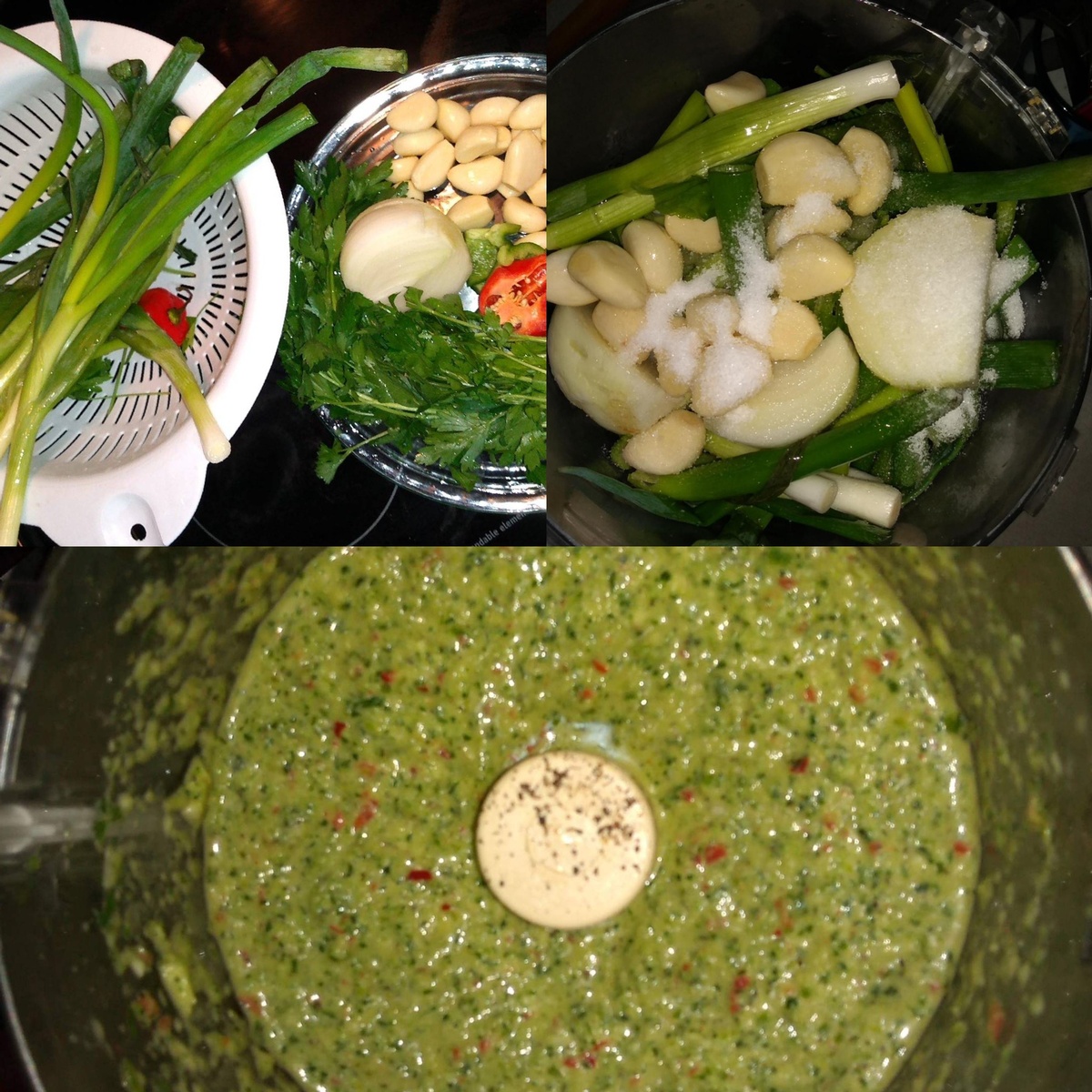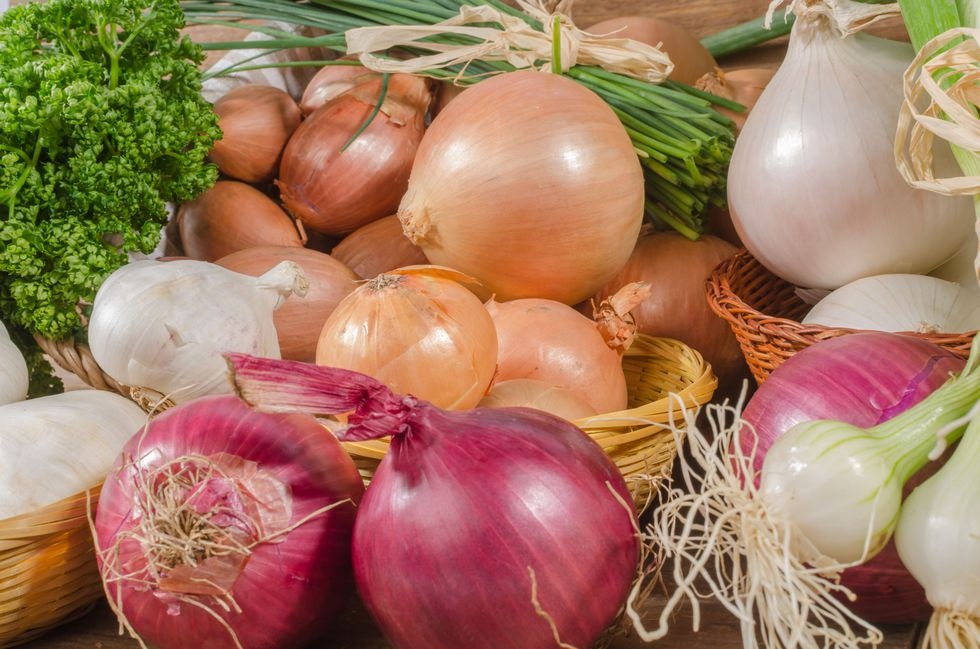by Kait P. with meaningful contributions by Chrissy D.
It's Alright to Cry! Have you ever wondered why onions make you cry? When was the last time you shed some tears while just trying to make dinner?
Onions contain a chemical called syn-Propanethial S-oxide that can turn to gas and trigger tears! You can try to prevent this by cooling the onion in the refrigerator before cutting or by improving the airflow in your cooking space by opening a window or turning on a fan.
Onions Across Tables
Onions are found in kitchens across the city and the world! This is in part because of their versatility in many recipes from all different cultures as well as how long onions can stay fresh. Onions can stay shelf-stable for weeks, when stored in a cool location. Onions are part of the allium family alongside leeks, garlic, shallots, scallions, and chives. The popular variety many of us can find in food stores in the U.S. are grown underground and are globe-shaped. These onions are slightly dried before selling to help improve the amount of time that they can be stored. They have a paper-like outer skin with many layers underneath, ranging in colors from white to yellow to red.
Onions for Nutrition
Eating onions brings health benefits since they are high in antioxidants as well as vitamins and minerals such as vitamin C and potassium. People have used onions in many folk medicine remedies because of these different properties. Some people even claim onions can provide relief for a bee sting, insect bite, or burn.
Onions for Flavor
Raw onions are crisp and have a sharp, pungent flavor. Some people like to eat them in sandwiches, tacos, salads, salsas, and just as an extra topping when they want something savory and crunchy. Onions can add flavor to a recipe without adding any extra seasoning or salt, so many people use them as the base of a recipe when they are cooking.
Preparing Onions
Check out the following video for onion-slicing tips! To prepare onions without the use of sharp tools, try removing one layer at a time and ripping or cutting each layer into smaller pieces with a butter knife. Onions can also be microwaved or baked whole as a way to soften them before adding them to recipes. Cooking onions on the stovetop at low heat for at least 20 to 30 minutes transforms a raw onion into a soft, translucent onion and then over time into a brown, caramelized onion. This low-and-slow cooking method helps bring out the sugars and transforms them from a sharp, crunchy, bright ingredient to one that is soft and sweet. Caramelized onions are great on sandwiches, pizza, flatbreads, and pasta.
Onions can also be made into chips, grilled, steamed, pickled, boiled, breaded and fried, roasted, and dehydrated and packaged as a seasoning!
 Epís was one of the first recipes Chrissy learned how to cook from her mom!
Epís was one of the first recipes Chrissy learned how to cook from her mom!Making and Eating Epís
Nourishing Literacy team member Chrissy loves to prepare and eat a Haitian seasoning paste called epís! Some of the things Chrissy appreciates about epís are:
- Epís recipes vary from person to person. It is nearly impossible to duplicate someone else's epis since people usually don’t document their recipe.
- It is a version of the Spanish sofrito that comes from the Catalan verb "sofrier" which means "to gently fry."
- It can be used as a base for sauces, stews, or marinades. Some cultures use epis as a finishing touch to dishes.
"Epís was one of the first things my mom taught me how to cook," Chrissy said. "When I was eight, she tested me one day and had me make it in the traditional way, all by feel, memory, and with a mortar and pestle. I vividly remember her teaching me how to use my senses in making and cooking epís: how to use sight to see the color of the scallions change after you add lime juice or how the chilis tickle your nose once the finished epís hits the hot oil. Till this day, the smell of a well-fried epís makes my mouth water and reminds me that something delicious is on its way.”
Ingredients for Chrissy’s Epís Recipe
- 3 to 4 bunches of scallions
- 2 to 3 bunches of parsley
- 2 to 3 bell peppers (any color)
- ½ large onion
- 1 cup peeled garlic cloves
- 1 scotch bonnet pepper
- 5 to 6 whole cloves (spice)
- 1 tablespoon thyme
- ¾ cup oil
- 1 bouillon cube
Steps for Chrissy's Epís Recipe
- Wash, trim, and chop scallions, parsley, bell peppers, onion, and garlic into pieces that you can place in a blender.
- If you're chopping the scotch bonnet pepper instead of placing it in the blender whole, wear gloves and be careful not to touch your eyes.
- Blend in stages
- First, blend the harder produce (garlic and onion)
- Next blend the softer produce (green onions, parsley, and peppers)
- Finally, add the cloves, thyme, oil, and bouillon cube
Your epís will be a beautiful green color! Place it in an airtight container and store it in the refrigerator for 1 week or the freezer for 6 months. And an extra tip from Chrissy! Pour your epís into a gallon-size, zip-top freezer bag and seal it well with no air. Lay the zip-top bag flat on a baking tray and then freeze it. Once frozen, you can break off your desired amount of epis.
Onions at the Library
Choose your own Library learning adventure for getting information about onions! Alexandria Giardino’s Ode to an Onion is a children’s book about poet Pablo Neruda, who with his friend Matilde, finds happiness even in sad times—all through an onion! This book is available for physical checkout with your library card. Kate Winslow’s Onion Etcetera is a cookbook with over 150 recipes featuring different ingredients from the allium family. You can read it online as an ebook with your Library card. For a fun song to listen to when cooking or eating, check out Booker T. & the MG’s "Green Onions” and “Mo’ Onions". These songs are on their greatest hits compilation The Very Best of Booker T. & The MGs.This CD is available at the library or you can listen on YouTube!
 Onions and onion skins can be used to create art!
Onions and onion skins can be used to create art!Art with Onions
When cooking with onions, try saving the skins! You can make your own natural dye using onion skins. Using a variety of onion colors will allow you to try new color combinations. The following video gives an overview of how-to dye onion skins, as well as how to achieve cool tie-dye looks. You can also try making a print using onions. Another video shares ideas that can be used not just with a halved onion, but with the remaining scraps of an onion, allowing you to make a painting with pieces that you are not going to eat. You can find more ideas for creating art with food scraps on Nourishing Literacy’s Making Sense of Food Scraps blog post.
How do onions inspire you to cook, eat, or create? Share your ideas in the comments!
____________________________________________________________________________________________________________________________________________
The Nourishing Literacy program offers food, literacy, wellness, and life skills activities and events to community members, with our core audience being the youth, teachers, and caregivers. Learn more about the Culinary Literacy Center online or on Instagram and Facebook.
The Nourishing Literacy program is made possible in part by a generous grant from the Edna G. Kynett Memorial Foundation.
Have a question for Free Library staff? Please submit it to our Ask a Librarian page and receive a response within two business days.

